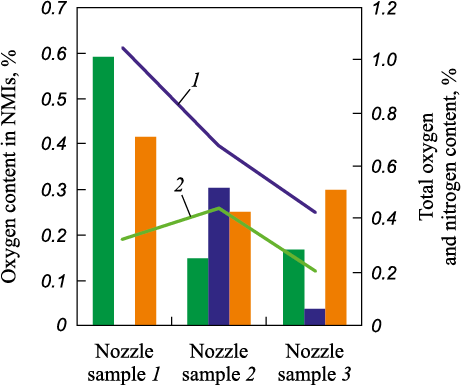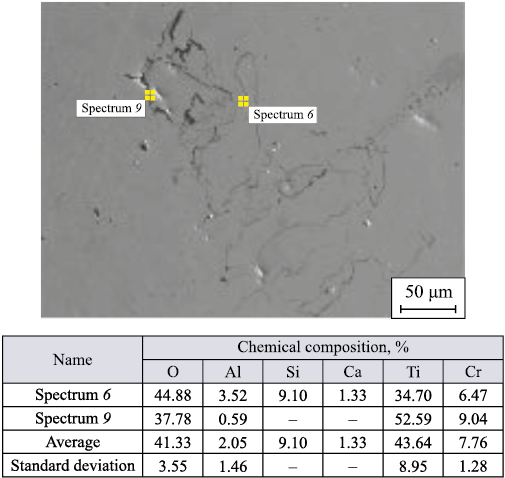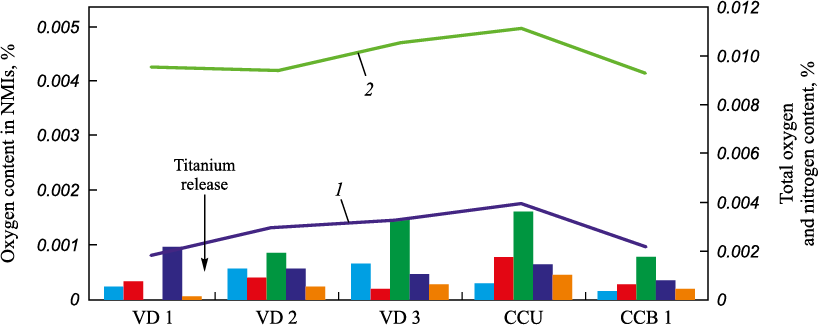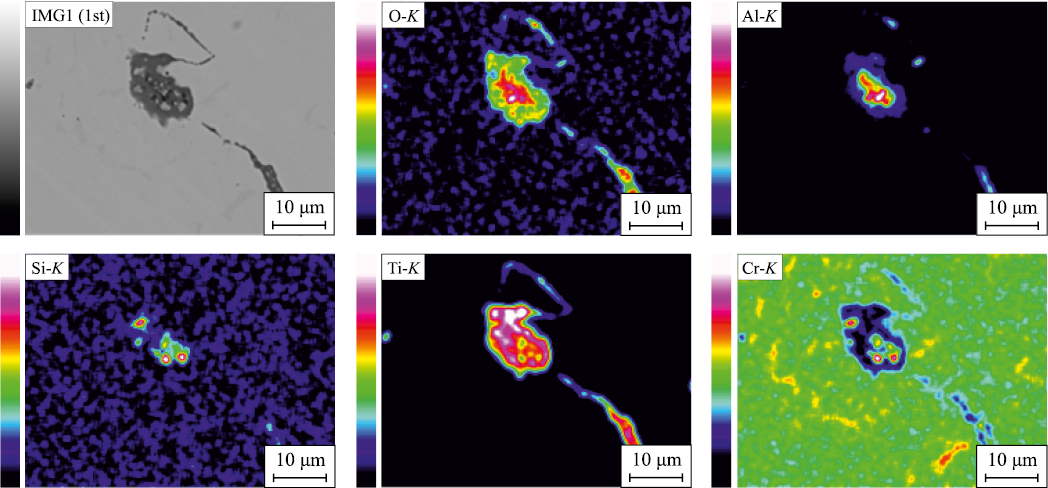Scroll to:
Formation of non-metallic inclusions in production of 08Kh18N10T corrosion-resistant steel
https://doi.org/10.17073/0368-0797-2024-5-549-555
Abstract
Corrosion-resistant steels are in demand in the modern world due to their high performance properties and a wide range of applications. Such areas of application include kitchenware, furniture, medical equipment, nuclear reactors, spacecraft, etc. Oxygen in steel, especially in corrosion-resistant steel, is one of the most harmful elements. Oxide inclusions disrupt the homogeneity of the metal, negatively affect the ductility, fracture toughness, fatigue strength and corrosion resistance of steel. In corrosion-resistant steels, non-metallic inclusions (NI) lead to the formation of defects in cold-rolled sheets. Aluminate inclusions also lead to clogging of steel-casting equipment. An analysis of the production technology of corrosion-resistant steel 08Kh8N10T was carried out in order to determine the causes of NI formation that affect the pourability of steel and its quality. The studies determined the content of total oxygen and nitrogen, as well as oxygen bound in various non-metallic inclusions at the stages of ladle processing and continuous steel casting. It was shown that after the introduction of titanium wire into the melt, the total nitrogen content decreases due to the formation and subsequent removal of titanium nitrides. At the same time, the content of titanium oxides in the melt increases. It was shown that the causes of clogging of steel-pouring nozzles during continuous casting are complex non-metallic inclusions based on titanium oxides, which were deposited on the inner surface of the pouring nozzle-doser. Recommendations were made to adjust the technology of steel melting in EAF and ladle processing. Based on the results of electron microscopic analysis, it was established that mixing of refining liquid-mobile slag in ladle steel processing units contributed to the assimilation of non-metallic inclusions by slag and a decrease in their sizes in the metal. After the implementation of the corrective recommendations, clogging of steel-pouring nozzles during continuous casting was not observed.
Keywords
For citations:
Em A.Yu., Komolova O.A., Grigorovich K.V., Rumyantseva S.B. Formation of non-metallic inclusions in production of 08Kh18N10T corrosion-resistant steel. Izvestiya. Ferrous Metallurgy. 2024;67(5):549-555. https://doi.org/10.17073/0368-0797-2024-5-549-555
Introduction
In 2023, the total global steel production amounted to 1.489 billion tons, with corrosion-resistant steel accounting for around 60 million tons. Corrosion-resistant steels play a key role in industry due to their high performance characteristics and wide range of applications [1 – 3].
Between 2015 and 2019, the production of corrosion-resistant steel continuously increased. The decrease in production in 2020 was due to the coronavirus pandemic during the first half of 2020, as many countries imposed lockdowns. However, following the recovery of the global economy in 2021, global production of corrosion-resistant steel increased by 11.6 % compared to 2020, not only reaching the record levels of 52.2 million tons in 2019, but also surpassing them to reach 56.8 million tons per year [4].
Corrosion-resistant steel production in Russia steadily increased from 2015 to 2023, reaching 278.2 thousand tons per year. At the same time, the consumption of corrosion-resistant steel in Russia exceeded domestic production by almost 2.5 times. Increasing the volume of corrosion-resistant steel production in Russia is, therefore, a highly relevant issue [4].
When smelting 08Kh18N10T corrosion-resistant steel, producers face problems such as clogging of the pouring nozzle dispensers, low yield, and surface defects [5 – 8]. The oxygen content in steel, particularly in corrosion-resistant grades, is one of the key indicators of the final product’s quality [9 – 11]. Dissolved oxygen in the metal reacts with deoxidizers, forming non-metallic inclusions (NMI). These NMIs compromise the integrity of the metal, adversely affecting ductility, toughness, fatigue strength, and corrosion resistance [12 – 14]. In corrosion-resistant steels, NMIs lead to the formation of defects such as “rub marks” in cold-rolled sheets, while Al2O3 inclusions contribute to the clogging of steel casting equipment during casting [15 – 17].
Deep surface defects in steel are caused by high levels of NMIs, such as oxides of chromium, manganese, silicon, aluminum, titanium, and titanium nitrides. In studies [11 – 12], the authors state that deep surface defects occur due to the entry of coarse slag crusts from the mold into the metal. The cause of the formation of these coarse slag-metal crusts is oxides and nitrides of titanium, which form as a result of the interaction of dissolved oxygen and nitrogen in the metal with titanium, a common alloying element [18].
This study analyzes the smelting, ladle processing, and casting technology of 08Kh18N10T corrosion-resistant steel to identify factors negatively impacting steel quality and NMI formation.
Materials and methods
To identify the causes of contamination of 08Kh18N10T corrosion-resistant steel by various NMIs, an analysis was performed using data from industrial heats’ passports and production records, and samples of metal were taken throughout the entire ladle processing chain for examination. The monitoring of changes in the content of the main types of oxide NMIs in metal samples selected at all stages of ladle processing, casting, and from continuously cast billets (CCB) was carried out using the method of fractional gas analysis (FGA). The study was conducted using a LECO TC600 gas analyzer with the original OxSeP Pro software. Fractional gas analysis is a modification of the method of reduction melting of the test sample in a graphite crucible in a stream of carrier gas at a specified linear heating rate [19 – 21].
To determine the morphology and chemical composition of the main types of NMIs found in the collected metal samples, a Jeol JXA-iSP100 EPMA scanning electron microscope with X-ray microanalysis was used, equipped with energy- and wavelength-dispersive spectrometers.
Results and discussion
During the study, metal samples taken throughout the entire production process were analyzed for two heats of 08Kh18N10T corrosion-resistant steel:
– heat 1: before the changes to the steel production technological parameters;
– heat 2: after the corrective actions were implemented.
Fig. 1 shows the results of determining the total oxygen and nitrogen content (right ordinate axis) as well as the oxygen content in various types of oxide NMIs (left ordinate axis) in the collected metal samples.
Fig. 1. FGA results of the metal samples of heat 1: |
During the casting process of heat 1, clogging of the pouring nozzles was observed. The FGA analysis of samples taken from the buildup on the pouring nozzle (Fig. 2) revealed high levels of total oxygen and nitrogen, as well as calcium aluminosilicates, spinels, and titanium oxides modified with calcium and magnesium.
Fig. 2. FGA results of metal samples taken from the clogging in pouring nozzle: |
At the technological stage of ladle-furnace unit (LFU) 4 – vacuum degasser (VD) 2 of heat 1, a decrease in the total oxygen and nitrogen content in the melt and an increase in the titanium oxide content were observed. In sample VD 3 of heat 1, chromium oxides, titanium oxides, and aluminates were detected.
In metal samples taken from the tundish of the continuous casting machine (CCM) 1 for heat 1, titanium oxides were mainly detected. It should be noted that the nitrogen content in the sample taken from the continuous casting unit (CCU) 1 for heat 1 increased by 20 ppm compared to the nitrogen content in the metal sample taken from the vacuum degasser (sample VD 3 of heat 1). At the same time, the total oxygen content decreased from 60 ppm (sample VD 3 of heat 1) to 30 – 40 ppm (sample CCU 1 of heat 1). The increase in nitrogen content in sample CCU 1 can be explained by the influence of secondary oxidation of the metal during casting. During secondary oxidation, the melt interacts with atmospheric air. The solubility limit of oxygen in aluminum-deoxidized steel does not exceed 0.0005 %, with the remaining oxygen present in oxide inclusions, which are partially removed into the slag during casting. The solubility limit of nitrogen in the molten metal at this temperature is determined by the concentration of alloying elements and is significantly higher than its actual concentration. This leads to an increase in the dissolved and total nitrogen content in the molten metal during secondary oxidation.
The results of the metal sample studies under an electron microscope confirm the results of the FGA. At the casting stage, oxide films larger than 400 µm were detected in metal samples from heat 1 (Fig. 3).
Fig. 3. Complex oxide NMI in selected metal samples |
Fig. 4 shows the results of metallographic studies of the chemical composition of samples taken from the clogging on the inner surface of the pouring nozzle. The study revealed:
– a high content of titanium oxides modified with calcium;
– the presence of conglomerates of calcium, silicon, aluminum, and titanium oxides;
– particles of undissolved ferrochrome and titanium nitrides;
– chromium oxides modified with titanium, silicon, and aluminum;
– calcium aluminosilicates, spinels, and titanium oxides modified with calcium and magnesium.
Fig. 4. Complex NMI in metal samples taken from the clogging on pouring nozzle surface |
It is likely that film conglomerates of NMIs, such as titanium oxides, titanium oxides with calcium and aluminum, as well as titanium nitrides, precipitating from the melt onto the walls of the pouring nozzle, formed a framework on which metal buildup accumulated, thus hindering the casting process. The high contamination of the metal with titanium oxides and nitrides indicates that the deoxidation technology currently used at the plant is not optimal. The significant increase in nitrogen content in the melt during casting, the presence of oxide films and stringer inclusions of titanium oxides in the melt, and the large amount of titanium nitrides in the finished metal may suggest the influence of secondary oxidation processes during casting.
During the study, recommendations were made to adjust the ladle processing technology, specifically: transferring the nickel alloying operation from the LFU to the EAF, introducing a refining fluid slag, and performing soft inert gas blowing of the melt for at least 15 min after the addition of SiCa. The plant conducted experimental heat 2, incorporating the provided recommendations. Metal samples were selected during the experimental heat. The results of determining the total oxygen and nitrogen content and the oxygen contained in various types of oxide NMIs in metal samples taken throughout the entire steel production process are shown in Fig. 5.
Fig. 5. FGA results of the metal samples of heat 2: |
According to Fig. 5, it can be seen that in sample VD 1 of heat 2, the primary type of NMI was aluminates. In sample VD 2, after the addition of titanium powder wire and silicon-calcium, a decrease in the aluminate content was observed, while the content of chromium, manganese, titanium oxides, and silicates increased. In samples VD 3 and CCM, there was an increase in the total oxygen and nitrogen content, which may indicate the occurrence of secondary oxidation of the metal. In samples from continuously cast billets (CCB), the primary type of NMIs were titanium oxides, with small amounts of aluminates, silicates, and spinels also present.
The analysis of the selected samples under an electron microscope confirmed the FGA results for the main groups of oxide NMIs. One of the results of element mapping of NMIs in the metal sample using micro-X-ray spectral analysis is shown in Fig. 6.
Fig. 6. Complex oxide NMI in selected metal sample |
Transferring the nickel alloying operation from the LFU to the EAF allowed the ladle processing time to be reduced by approximately one hour. The reduction in metal processing time in the LFU led to a decrease in the operating time of the electric arcs, which are a significant source of nitrogen entry into the metal melt. This also reduced the wear of the lining and minimized contamination of the melt by the products of lining degradation. Based on the results of electron microscope studies, it was determined that the introduction of fluid refining slag led to the removal of NMIs and a reduction in their size – the inclusions became smaller (heat 2). No clogging of the pouring nozzles was observed in the experimental heat after the corrective actions were implemented.
Conclusions
An analysis of the production technology of 08Kh18N10T corrosion-resistant steel was performed to determine the causes of NMI formation that affect the pourability and quality of the metal. During the study, the total oxygen and nitrogen content, as well as the oxygen contained in various types of oxide NMIs at the stages of ladle processing and casting, were determined. The results of the electron microscope analysis confirmed the FGA findings, specifically the predominance of NMIs that are detrimental to corrosion-resistant steels: titanium oxides and nitrides, as well as aluminates. It was shown that after the addition of titanium wire, the total nitrogen content decreased due to the formation of titanium nitrides, which were subsequently removed into the slag. At the same time, an increase in titanium oxide content was observed. It was demonstrated that the cause of clogging of the casting equipment is the formation of complex NMIs based on titanium oxide, which “stick” to the surface of the pouring nozzle during steel casting.
Recommendations were made to adjust the ladle processing technology. Based on the results of electron microscope studies, it was determined that the induction of fluid refining slag contributed to the assimilation of NMIs and their size reduction (heat 2). After the implementation of corrective measures, no clogging of the casting equipment was observed.
References
1. Beddoes J., Parr J.G. Introduction to Stainless Steels. 3rd ed. Materials Park, OH, USA: ASM International; 1999:315.
2. Novak C.J., Peckner D., Bernstein I.M. Handbook of Stainless Steels. New York: McGraw-Hill; 1977:1120.
3. Lakshmi A.A., Rao Ch.S., Gangadhar J., Srinivasu Ch., Singh S.K. Review of processing maps and development of qualitative processing maps. Materials Today: Proceedings. 2017;4(2):946–956. https://doi.org/10.1016/j.matpr.2017.01.106
4. Volkova A.V. Market of Stainless Steel Products – 2021. HSE University; 2021:76. (In Russ.).
5. Tokovoy O.K., Shaburov D.V. Study of “cake” defect in continuously cast austenitic stainless steel 18Cr-10Ni-1Ti. Report 1. Izvestiya. Ferrous Metallurgy. 2013;56(7):19–22. (In Russ.). https://doi.org/10.17073/0368-0797-2013-7-19-22
6. Surgaeva E.V., Elanskii G.N., Galkin M.P., Yachmeneva N.A. Investigation of slag-metal crust formed in the mold during continuous casting of 08Kh17T steel. Elektrometallurgiya. 2002;(5):22–25. (In Russ.).
7. Surgaeva E.V., Galkin M.P., Elanskii G.N. The work of slag-forming mixture in CCM mold during casting of corrosion-resistant titanium-containing steels. In: Transactions of the 7th Congress of Steelmakers. 2002:524–529. (In Russ.).
8. Elanskii G.N., Paderin S.N., Surgaeva E.V. The causes of captivity and slag-metal crusts during casting of titanium-containing corrosion-resistant steels. Stal’. 2005;(9):17–19. (In Russ.).
9. Sowa L., Bokota A. Numerical model of thermal and flow phenomena the process growing of the CC slab. Archives of Metallurgy and Materials. 2011;56(2):359–366. https://doi.org/10.2478/v10172-011-0038-4
10. Wegrzyn T., Miroslawski J., Silva A.P., Pinto D.G., Miros M. Oxide inclusions in steel welds of car body. Materials Science Forum. 2010;636–637:585–591. https://doi.org/10.4028/www.scientific.net/MSF.636-637.585
11. Hashimoto K., Fujimatsu T., Tsunekage N., Hiraoka K., Kida K., Costa Santos E. Study of rolling contact fatigue of bearing steels in relation to various oxide inclusions. Materials & Design. 2011;32(3):1605–1611. https://doi.org/10.1016/j.matdes.2010.08.052
12. Zhang L., Thomas B.G. State of the art in the control of inclusions during steel ingot casting. Metallurgical and Materials Transactions B. 2006;37(5):733–761. https://doi.org/10.1007/s11663-006-0057-0
13. Zhang L. Indirect methods of detecting and evaluating inclusions in steel – A review. Journal of Iron and Steel Research International. 2006;13(4):1–8. https://doi.org/10.1016/s1006-706x(06)60067-8
14. Zhang L. Nucleation, growth, transport, and entrapment of inclusions during steel casting. JOM. 2013;65(9):1138–1144. https://doi.org/10.1007/s11837-013-0688-y
15. Gao Y., Sorimachi K. Formation of clogging materials in an immersed nozzle during continuous casting of titanium stabilized stainless steel. ISIJ International. 1993;33(2):291–297. https://doi.org/10.2355/isijinternational.33.291
16. Sasai K., Mizukami Y. Mechanism of alumina adhesion to continuous caster nozzle with reoxidation of molten steel. ISIJ International. 2001;41(11):1331–1339. https://doi.org/10.2355/isijinternational.41.1331
17. Long M., Zhang L., Zuo X., Chen D. Kinetic modeling on nozzle clogging during steel billet continuous casting. ISIJ International. 2010;50(5):712–720. https://doi.org/10.2355/isijinternational.50.712
18. Lozovskii E.P., Ushakov S.N., Yurechko D.V. Causes of formation of a “captivity” defect due to non-metallic inclusions in slabs on rolled products. Stal’. 2009;(10):26–28. (In Russ.).
19. Grigorovich K.V., Krasovskii P.V., Isakov S.A., Gorokhov A.A., Krylov A.S. Processing and interpretation of the results of fractional gas analysis. Zavodskaya laboratoriya. Diagnostika materialov. 2002;68(9):3–9. (In Russ.).
20. Grigorovich K., Komolova O., Terebikina D. Analysis and optimization of ladle treatment technology of steels processing. Journal of Chemical Technology and Metallurgy. 2015;50(6):574–580.
21. Shibaev S.S., Krasovskii P.V., Grigorovich K.V. Determination of oxygen concentrations in stainless steels by the method of reducing melting. Zavodskaya laboratoriya. Diagnostika materialov. 2006;72(6):10–16. (In Russ.).
About the Authors
A. Yu. EmRussian Federation
Anton Yu. Em, Junior Researcher of the Laboratory of Materials Diagnostics
49 Leninskii Ave., Moscow 119991, Russian Federation
O. A. Komolova
Russian Federation
Ol’ga A. Komolova, Cand. Sci. (Eng.), Senior Researcher of the Laboratory of Materials Diagnostics, Baikov Institute of Metallurgy and Materials Science, Russian Academy of Sciences; Assist. Prof. of the Chair of Metallurgy of Steel, New Production Technologies and Metal Protection, National University of Science and Technology “MISIS”
49 Leninskii Ave., Moscow 119991, Russian Federation
4 Leninskii Ave., Moscow 119049, Russian Federation
K. V. Grigorovich
Russian Federation
Konstantin V. Grigorovich, Academician, Dr. Sci. (Eng.), Head of the Laboratory of Materials Diagnostics, Baikov Institute of Metallurgy and Materials Science, Russian Academy of Sciences; Prof. of the Chair of Metallurgy of Steel, New Production Technologies and Metal Protection, National University of Science and Technology “MISIS”
49 Leninskii Ave., Moscow 119991, Russian Federation
4 Leninskii Ave., Moscow 119049, Russian Federation
S. B. Rumyantseva
Russian Federation
Sof’ya B. Rumyantseva, Cand. Sci. (Eng.), Research Associate of the Laboratory of Materials Diagnostics
49 Leninskii Ave., Moscow 119991, Russian Federation
Review
For citations:
Em A.Yu., Komolova O.A., Grigorovich K.V., Rumyantseva S.B. Formation of non-metallic inclusions in production of 08Kh18N10T corrosion-resistant steel. Izvestiya. Ferrous Metallurgy. 2024;67(5):549-555. https://doi.org/10.17073/0368-0797-2024-5-549-555







































